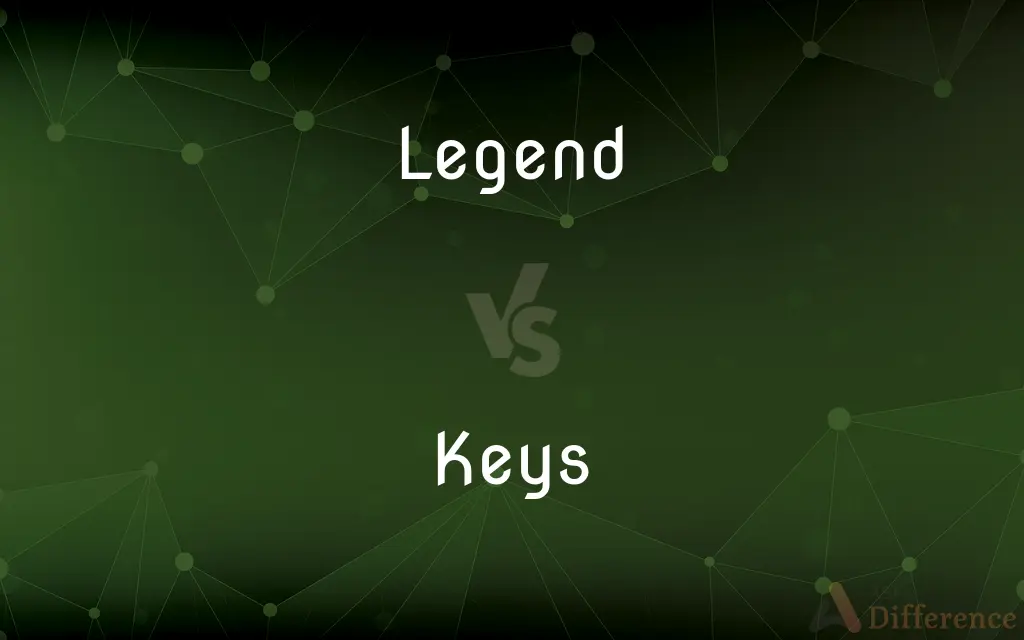Legend vs. Keys — What's the Difference?
By Tayyaba Rehman & Maham Liaqat — Updated on April 4, 2024
A legend explains symbols or colors on a map or chart, while keys are tools or principles for interpreting or solving something.

Difference Between Legend and Keys
Table of Contents
ADVERTISEMENT
Key Differences
A legend on a map or chart serves as a crucial explanatory tool, detailing what specific symbols, colors, or patterns represent. It's a guide that allows the user to understand the visual shorthand used in these informational tools. Keys, in a broader sense, offer a means of access or principles for understanding or interpreting various types of information or data. While both legends and keys provide clarity and understanding, legends are specific to visual representations, whereas keys can be more widely applicable.
Legends are typically found alongside visual data presentations, such as maps, graphs, and charts, where they decode the symbols and colors used, making the information accessible and understandable. Keys, however, can refer to physical objects that unlock something, metaphorical tools that provide critical understanding, or the principles that underlie a system, such as musical keys in music or key terms in a text.
In the context of maps or diagrams, the terms "legend" and "keys" are sometimes used interchangeably, but their applications extend beyond. A legend is more narrowly defined and specific to its context, offering a direct link between symbols and their meanings. Keys, on the other hand, encompass a broader range of applications, from cryptographic keys that decrypt data to keywords that aid in searching or categorizing information.
The effectiveness of a legend lies in its ability to simplify and clarify complex information, making it essential for the user's comprehension of visual data. Keys, in their various forms, unlock deeper understandings, provide solutions, or grant access, highlighting their fundamental role in interpretation and discovery across different fields.
While a legend is a static component of a visual aid, designed to accompany and elucidate a specific set of symbols or data, keys are more dynamic and can evolve or exist in multiple formats depending on their purpose. This distinction underscores the functional and contextual differences between the two, emphasizing the legend's role in immediate clarification and the key's role in broader interpretation or access.
ADVERTISEMENT
Comparison Chart
Definition
Explains symbols or colors in a visual representation.
Tools or principles for interpreting, solving, or accessing something.
Usage Context
Maps, charts, and diagrams to decode visual information.
Broad, including physical objects, concepts, or principles.
Purpose
To make visual information understandable.
To provide access, understanding, or solutions.
Specificity
Specific to the symbols and colors in its context.
Can be applicable across various contexts and fields.
Types
Found in visual aids.
Physical keys, keywords, cryptographic keys, musical keys, etc.
Compare with Definitions
Legend
Integral to understanding complex visual data.
The geological map's legend helped identify different rock types.
Keys
Used in a wide range of fields and contexts.
Musical keys are foundational in composing and performing music.
Legend
Essential for the user's comprehension of visual aids.
The legend clarified the meanings of various colored areas.
Keys
Principles or tools for solving, interpreting, or accessing.
The book provided keys to understanding complex concepts.
Legend
To make the visual representation comprehensible.
Without the legend, interpreting the chart would be challenging.
Keys
Adaptable and evolving according to need.
Cryptographic keys secure digital communications.
Legend
A guide explaining symbols, colors, or patterns on maps or charts.
The legend on the map indicated that blue lines represented rivers.
Keys
Facilitates access, understanding, or categorization.
Keywords are essential for effective information retrieval.
Legend
Usually a small, distinct section of the visual aid.
The diagram's legend was positioned in the lower-right corner.
Keys
Includes physical, conceptual, and metaphorical types.
The key to the puzzle was a simple mathematical principle.
Legend
A legend is a genre of folklore that consists of a narrative featuring human actions perceived or believed both by teller and listeners to have taken place within human history. Narratives in this genre may demonstrate human values, and possess certain qualities that give the tale verisimilitude.
Keys
A notched and grooved, usually metal implement that is turned to open or close a lock.
Legend
An unverified story handed down from earlier times, especially one popularly believed to be historical.
Keys
A similar implement or an electronic device used for opening, winding, or starting something
The key of a wind-up alarm clock.
The new car's electronic key.
Legend
A body or collection of such stories.
Keys
A device, such as a wedge or pin, inserted to lock together mechanical or structural parts.
Legend
See urban legend.
Keys
A keycard.
Legend
One that inspires legends or achieves legendary fame
She is a legend in her own time.
Keys
A determining factor in accomplishing or achieving something
One key to the store's success has been consistent customer service.
Legend
An inscription or title on an object, such as a coin.
Keys
Something that provides access to or understanding of something else
The key to the mystery was a drug store receipt.
Legend
An explanatory caption accompanying an illustration.
Keys
A set of answers to a test.
Legend
An explanatory table or list of the symbols appearing on a map or chart.
Keys
A table, gloss, or cipher containing correspondences, as for decoding or interpreting something.
Legend
An unrealistic story depicting past events.
Keys
(Computers) A number used by a cryptographic algorithm to encrypt or decrypt data.
Legend
A story of unknown origin describing plausible but extraordinary past events.
The legend of Troy was discovered to have a historical basis.
Keys
(Architecture) The keystone in the crown of an arch.
Legend
A plausible story set in the historical past, but whose historicity is uncertain.
The legend of Robin Hood
Keys
A button or lever that is depressed to operate a machine.
Legend
A story in which a kernel of truth is embellished to an unlikely degree.
The 1984 Rose Bowl prank has spawned many legends. Here's the real story.
Keys
A button that is depressed to cause a corresponding character or function to be typed or executed by a typewriter or to be accepted as input by a computer.
Legend
A fabricated backstory for a spy, with associated documents and records.
According to his legend, he once worked for the Red Cross, spreading humanitarian aid in Africa.
Keys
(Music) A button or lever that is depressed with the finger to produce or modulate the sound of an instrument, such as a clarinet or piano.
Legend
A person related to a legend or legends.
Keys
A tonal system consisting of seven tones in fixed relationship to a tonic, having a characteristic key signature and being the structural foundation of the bulk of Western music; tonality.
Legend
A leading protagonist in a historical legend.
Achilles is a legend in Greek culture.
Keys
The principal tonality of a work
An etude in the key of E.
Legend
A person with legend-like qualities, such as extraordinary accomplishment.
Michael Jordan stands as a legend in basketball.
Keys
The pitch of a voice or other sound.
Legend
A key to the symbols and color codes on a map, chart, etc.
According to the legend on the map, that building is a school.
Keys
A characteristic tone or level of intensity, as of a speech or sales campaign. Often used in combination
High-key.
Low-key.
Legend
An inscription, motto, or title, especially one surrounding the field in a medal or coin, or placed upon a heraldic shield or beneath an engraving or illustration.
Keys
(Botany) A samara.
Legend
A musical composition set to a poetical story.
Keys
An outline of the distinguishing characteristics of a group of organisms, used as a guide in taxonomic identification.
Legend
(naval) The design and specification of a vessel.
Keys
(Basketball) An area at each end of the court between the baseline and the foul line and including the jump-ball circle at the foul line
A jump shot from the top of the key.
Legend
To tell or narrate; to recount.
Keys
The act of replacing portions of a video or photograph containing a preselected color with material from a separate image, as by chroma key.
Legend
That which is appointed to be read; especially, a chronicle or register of the lives of saints, formerly read at matins, and in the refectories of religious houses.
Keys
A low offshore island or reef, especially in the Gulf of Mexico; a cay.
Legend
A story respecting saints; especially, one of a marvelous nature.
Keys
A kilogram of marijuana, cocaine, or heroin.
Legend
Any wonderful story coming down from the past, but not verifiable by historical record; a myth; a fable.
And in this legend all that glorious deed Read, whilst you arm you.
Keys
Of crucial importance; significant
Key decisions.
The key element of the thesis.
Legend
An inscription, motto, or title, esp. one surrounding the field in a medal or coin, or placed upon an heraldic shield or beneath an engraving or illustration.
Keys
To lock with a key.
Legend
To tell or narrate, as a legend.
Keys
To be the determining or crucial factor in
A double that keyed a three-run rally in the fifth inning.
Legend
A story about mythical or supernatural beings or events
Keys
(Architecture) To furnish (an arch) with a keystone.
Legend
Brief description accompanying an illustration
Keys
(Music) To regulate the pitch of.
Keys
To bring into harmony; adjust or adapt
"achievement tests that are more clearly keyed to what students are held responsible for in high school" (New York Times).
Keys
To cause to pay attention to
School officials who were keyed into the dietary needs of students.
Keys
To supply with a key of correspondences or with corresponding references
Keyed the pages in the edited book to illustrations in the manuscript.
Keys
To operate (a device), as for typesetting, by means of a keyboard.
Keys
To enter (data) into a computer by means of a keyboard.
Keys
To identify (a biological specimen).
Keys
To vandalize or mar by scratching with a key
Vandals keyed the cars left in the parking garage.
Keys
To produce, replace, or include by chroma key.
Keys
To pay close attention; focus
Improved service by keying on customer complaints.
Keyed into the main points of the lecture.
Keys
(Sports) To watch or cover an opposing player closely in an effort to limit the player's effectiveness. Used with on
"[She] still carries the burden of scoring ... even though opponents key on her throughout every game" (Josh Barr).
Keys
To replace portions of a video or photograph containing a preselected color with material from a separate image, as by chroma key.
Keys
Plural of key
Common Curiosities
How do keys function?
Keys serve as tools or principles for understanding, solving, or accessing something.
Why are legends important in charts or maps?
They decode the visual information, making it accessible and understandable to the viewer.
What does a legend do?
It explains the symbols, colors, and patterns used in a visual representation.
What are examples of keys outside of maps?
Examples include physical keys for locks, cryptographic keys for security, and keywords for search optimization.
How can keys be applied in digital security?
Cryptographic keys are used to encrypt and decrypt data, ensuring secure communication.
Can legends and keys be considered the same in maps?
In maps, the terms are sometimes used interchangeably, but "legend" is more specifically correct.
Is a legend always present in visual data presentations?
While not always present, a legend is crucial for complex or detailed visual information.
Can the absence of a legend affect data interpretation?
Yes, without a legend, the viewer may find it difficult to understand the symbols or data presented.
How do keys aid in learning?
Keys provide fundamental principles or methods that unlock understanding or problem-solving in various subjects.
Why are keys essential in cryptography?
They secure digital information by encrypting data, making it readable only by authorized parties.
What makes a key different from a legend?
A key is broader, referring to tools or principles for access or understanding, beyond just visual aids.
How do legends and keys enhance user experience?
They provide clarity, access, and understanding, improving interaction with physical and digital environments.
What role do keywords play in information retrieval?
Keywords help categorize and search for information efficiently in databases or the internet.
Can a musical piece have multiple keys?
Yes, a composition can change keys, affecting its mood and complexity.
How does one create an effective legend?
By clearly linking symbols to their meanings in a concise and visible format.
Share Your Discovery

Previous Comparison
Aesthetic vs. Cosmetic
Next Comparison
Hide vs. HydeAuthor Spotlight
Written by
Tayyaba RehmanTayyaba Rehman is a distinguished writer, currently serving as a primary contributor to askdifference.com. As a researcher in semantics and etymology, Tayyaba's passion for the complexity of languages and their distinctions has found a perfect home on the platform. Tayyaba delves into the intricacies of language, distinguishing between commonly confused words and phrases, thereby providing clarity for readers worldwide.
Co-written by
Maham Liaqat













































